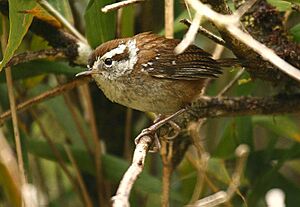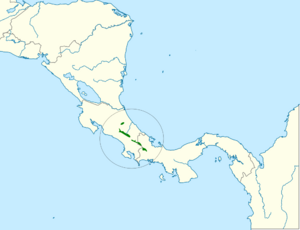Timberline wren facts for kids
Quick facts for kids Timberline wren |
|
|---|---|
 |
|
| Conservation status | |
| Scientific classification | |
| Genus: |
Thryorchilus
|
| Species: |
browni
|
 |
|
The timberline wren (Thryorchilus browni) is a small bird that lives in the mountains of Costa Rica and western Panama. It belongs to the Troglodytidae family, which are often called wrens.
Contents
About the Timberline Wren
The timberline wren is the only bird in its group, called Thryorchilus. Scientists sometimes discuss if there are different types (subspecies) of this wren. Most agree it's just one kind of bird.
What Does It Look Like?
This little wren is about 10 cm (3.9 in) long, which is about the length of your hand. It weighs around 14 g (0.49 oz), which is lighter than a few coins.
Its head and back are a rich chestnut brown color. Its tail is reddish brown with thin dark lines. It has a clear gray-white stripe above its eye, like an eyebrow. Behind its eye, there's a chocolate brown stripe.
Its throat and chest are grayish white. The lower part of its belly is brown, and its sides are reddish brown. Young wrens look a bit grayer underneath.
Where Does It Live?
The timberline wren lives in different mountain areas of Costa Rica and northern Panama. It likes to live in high, open grasslands called páramo. These areas are found at the very top edge of where trees can grow.
It especially likes places with thick bamboo plants. You can usually find these wrens between 2,800 and 3,600 m (9,200 and 11,800 ft) high in the mountains. Sometimes, they might be seen as low as 2,200 m (7,200 ft).
How Does It Behave?
What Does It Eat?
The timberline wren usually looks for food on or close to the ground. It might flutter to grab insects from leaves. It also creeps along mossy branches to find its meals. Its diet includes small insects, caterpillars, and spiders.
Reproduction and Nests
In Costa Rica, timberline wrens build their nests and have babies from April to June. Their nest is shaped like a hollow ball. They build it from bamboo leaves and line it with softer materials inside.
The nest has an opening on the side. They usually place it about 1 to 3 m (3.3 to 9.8 ft) high in bamboo plants or small bushes. A mother wren typically lays two eggs.
What Does It Sound Like?
The timberline wren has a unique song. It's a repeated sound that lasts about 2 to 3 seconds. It sounds like "a series of half a dozen scratchy, warbling notes." When it wants to warn others, its call is a "harsh scolding 'churr'."
Is It Safe?
The IUCN (International Union for Conservation of Nature) says the timberline wren is a species of "Least Concern." This means it's not currently in danger of disappearing. Even though it lives in a specific area, it's quite common there. Many places where it lives are national parks, which helps protect its home from human activities.


